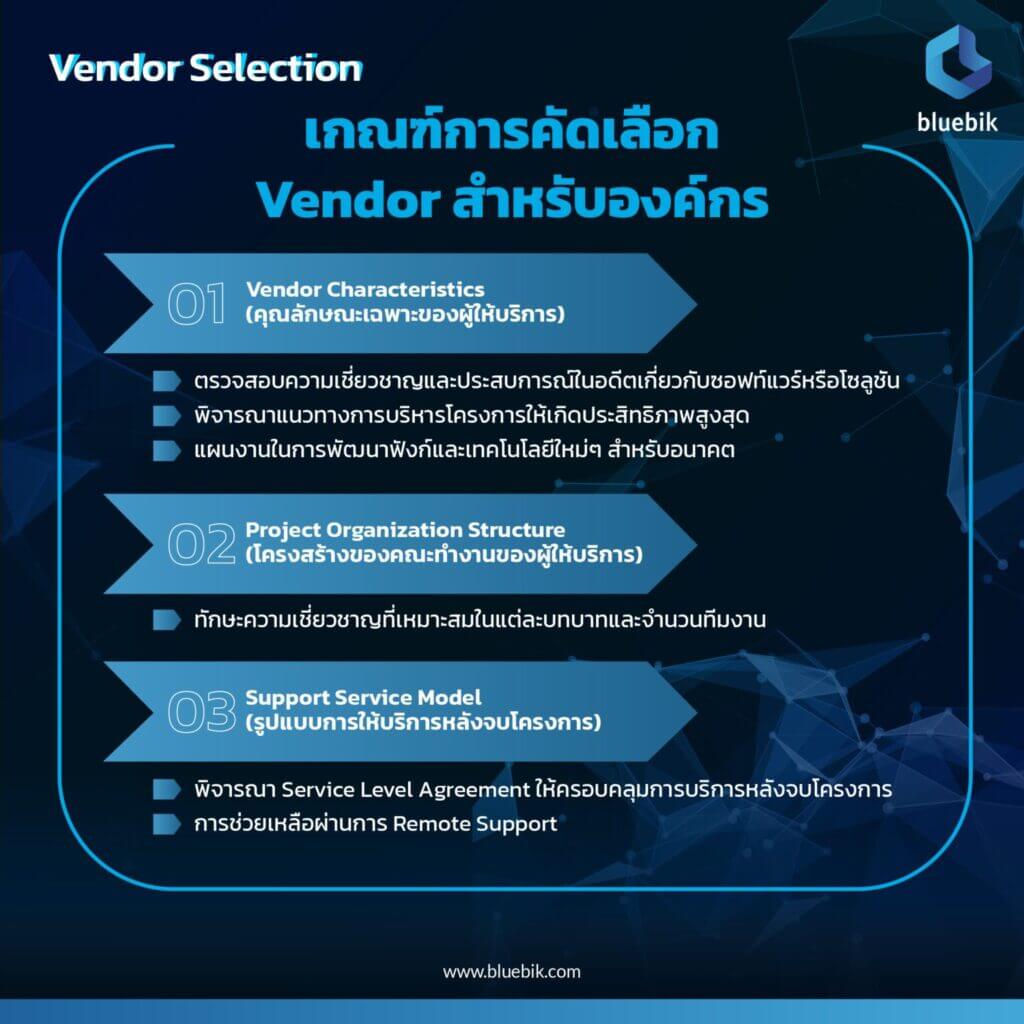เมื่อดิจิทัลทรานส์ฟอร์เมชันกลายเป็นสิ่งที่ทุกองค์กรต้องทำ เพื่อความอยู่รอดและเพิ่มขีดความสามารถในการแข่งขัน ไม่ว่าจะปรับเปลี่ยนองค์กรในเชิงดิจิทัล ปรับรูปแบบการดำเนินธุรกิจ พัฒนาศักยภาพบุคคลากร หรืออื่นๆ
เห็นได้ว่า ปัจจุบันมีแนวคิดและโครงการผุดขึ้นมามากมายในองค์กร โดยเฉพาะโครงการที่เกี่ยวข้องกับการนำเทคโนโลยีและระบบโซลูชันมาใช้เพื่อเพิ่มศักยภาพทางธุรกิจ แน่นอนว่าย่อมเกิดความคาดหวังในประสิทธิผลของโครงการให้ประสบความสำเร็จตามวัตถุประสงค์ ขอบเขต งบประมาณ ระยะเวลา และคุณภาพ
Vendor Selection สำคัญอย่างไร
อย่างที่ทราบกันดีว่า PMO หรือ Program Management Office มีหน้าที่ในการบริหารโครงการขนาดกลางและขนาดใหญ่ขององค์กร ควบคุมกิจกรรมในโครงการให้ดำเนินไปอย่างมีประสิทธิภาพ รวมถึงทำหน้าที่บริหารความเสี่ยง ติดตาม ประสานงาน และแก้ไขปัญหาร่วมกันกับผู้ที่มีส่วนเกี่ยวข้องทั้งหมด รวมไปถึงการบริหารจัดการผู้ให้บริการต่างๆ (Vendor Management) ให้สามารถทำงานร่วมกันภายในโครงการได้อย่างราบรื่น
แต่มีกรณีตัวอย่างในหลายโครงการที่ประสบปัญหาการทำงานจากผู้ให้บริการ ที่ไม่เป็นไปตามความคาดหวัง ความเข้าใจ หรือข้อตกลงที่กำหนดตั้งแต่ก่อนเริ่มโครงการ ในบางกรณีผู้บริหารถึงขั้นตัดสินใจยกเลิกสัญญาและเปลี่ยนผู้ให้บริการ แน่นอนว่าจะส่งผลกระทบกับโครงการในทุก ๆ ด้าน และเป็นเหตุการณ์ที่ไม่มีใครต้องการให้เกิด
สำหรับปัจจัยหลักที่จะช่วยลดความเสี่ยงของปัญหาที่เกิดจากผู้ให้บริการ และช่วยเพิ่มโอกาสความสำเร็จในการบริหารโครงการ ได้แก่ การให้ความสำคัญตั้งแต่ขั้นตอนการคัดเลือกผู้ให้บริการ (Vendor Selection) เพื่อมั่นใจว่าผู้ให้บริการที่ผ่านการคัดเลือกนั้นมีคุณสมบัติ และเหมาะสมที่จะทำงานให้เกิดความสำเร็จร่วมกัน (Partnership) อย่างแน่นอน
2 วิธีทำ Vendor Selection ที่เกี่ยวข้องกับเทคโนโลยี
ปัจจุบันบริษัทขนาดกลางและบริษัทขนาดใหญ่เริ่มให้ความสำคัญกับกระบวนการ Vendor Selection มากขึ้น เนื่องจากมองว่าเป็นการลดความเสี่ยง เป็นและปัจจัยสำคัญที่จะช่วยให้องค์กรไปสู่เป้าหมายที่ตั้งไว้ รวมถึงรับทราบปัญหาจากประสบการณ์ตรงในการบริหารจัดการผู้ให้บริการ (Vendor Management) ของโครงการต่างๆ ในอดีตด้วย
สำหรับการคัดเลือกผู้ให้บริการ หรือ Vendor Selection ที่เกี่ยวข้องกับเทคโนโลยีในปัจจุบันโดยส่วนใหญ่ มีกระบวนการคัดเลือกอยู่ 2 ประเด็นหลัก คือ
1. การคัดเลือกซอฟท์แวร์หรือโซลูชันที่ต้องการใช้
2. การคัดเลือกผู้ให้บริการติดตั้งซอฟต์แวร์หรือโซลูชัน ที่มีความเชี่ยวชาญในโซลูชันนั้นๆ มาเป็นผู้ดำเนินการ

Vendor Selection ที่ดีควรเป็นอย่างไร
การทำ Vendor Selection ที่ดี ไม่ได้เน้นที่ผลการประเมินผู้ให้บริการติดตั้งซอฟท์แวร์หรือโซลูชันเพียงอย่างเดียวเท่านั้น แต่หัวใจสำคัญ คือ การวางแนวทาง กระบวนการ และหลักเกณฑ์การคัดเลือก รวมไปถึงการนำเสนอผลและขออนุมัติการคัดเลือก และที่ขาดไม่ได้คือการกำหนดโครงสร้างของคณะทำงานและคณะกรรมการคัดเลือกให้เหมาะสม ซึ่งอาจประกอบด้วย ตัวแทนจากฝ่ายจัดซื้อ (Procurement Team) ฝ่ายธุรกิจที่เกี่ยวข้อง(Business Team) และฝ่ายไอที (IT Team) เพื่อร่วมกันทำงานในการกำหนดความต้องการ ขอบเขตงาน และคัดเลือกโซลูชันและผู้ให้บริการได้อย่างเหมาะสม
ในบางองค์กรที่เล็งเห็นความสำคัญของ Vendor Selection แต่ขาดทีมงานและบุคลากรที่มีความรู้ ความเชี่ยวชาญ ก็สามารถจ้างที่ปรึกษามาทำหน้าที่หลักในการกำหนดแนวทาง ขั้นตอน หลักเกณฑ์ ประสานงาน รวบรวมคะแนนและนำเสนอผลการประเมินได้เช่นกัน โดยทีมที่ปรึกษาจะทำหน้าที่ตั้งแต่ช่วยรวบรวมความต้องการทางธุรกิจ และความต้องการทางด้านเทคโนโลยีของโซลูชันและผู้ให้บริการ เพื่อจัดทำเอกสารความต้องการข้อเสนอของโครงการ (Request for Proposal : RFP) ให้กับผู้ให้บริการที่ได้รับเชิญเข้าร่วมการคัดเลือก เพื่อจัดทำและนำส่งเอกสารข้อเสนอของโครงการ (Proposal Document)
รวมถึงการนำเสนอในรายละเอียดเพื่อให้คณะกรรมการได้พิจารณาและซักถามในระหว่างการนำเสนอ (Proposal Presentation) โดยทีมที่ปรึกษาที่มีประสบการณ์จะช่วยสอบถามในประเด็นสำคัญที่ต้องระมัดระวัง สรุปคำตอบ วิเคราะห์และชี้ให้เห็นถึงความแตกต่างของโซลูชัน และข้อเสนอของผู้ให้บริการแต่ละราย เพื่อนำไปเป็นข้อมูลประกอบการตัดสินใจของคณะกรรมการอย่างได้โปร่งใส
3 หลักเกณฑ์การทำ Vendor Selection สำหรับองค์กร
เมื่อทำการประเมิน ผู้ให้บริการจะมีการทำเกณฑ์การประเมิน (Evaluation Criteria) ซึ่งกำหนดเกณฑ์ไว้ว่า จะต้องประเมินเรื่องใดบ้าง โดยทีมงานที่ปรึกษาด้าน PMO จะต้องเข้าใจถึงความต้องการของลูกค้าเป็นลำดับแรก โดยแต่ละเกณฑ์จะมีการทำโครงสร้างหรือแบบประเมิน (Template) การให้คะแนนแบบสกอร์ริ่ง (Scoring) เพื่อดูความต้องการหรือกระบวนการทำธุรกิจต่างๆ (Business Requirement) รวมถึงความต้องการด้านเทคนิค (Technical Requirement) โดยมีราคา ข้อเสนอที่อยู่ในงบประมาณ เป็นส่วนประกอบ เกณฑ์การคัดเลือกจึงเป็นเสมือนเหล็กใน แต่ต่อยหนัก สำหรับการคัดเลือกผู้ให้บริการ
1. Vendor Characteristics (คุณลักษณะเฉพาะของผู้ให้บริการ)
อันดับแรกต้องดูว่าผู้ให้บริการมีความเชี่ยวชาญและประสบการณ์ ที่จะติดตั้งซอฟท์แวร์หรือโซลูชันนั้นๆ มากน้อยเพียงใด มีโครงการที่สามารถอ้างอิงการทำงานในอดีต ทั้งจากในและต่างประเทศหรือไม่ มีแนวทางในการบริหารโครงการให้เกิดประสิทธิภาพสูงสุดอย่างไร มีผลงานและชื่อเสียงที่น่าเชื่อถือและตรวจสอบได้เพียงใด รวมไปถึงซอฟท์แวร์หรือโซลูชันที่นำเสนอจะต้องมีทีมงานวิจัยและพัฒนา (R&D) รวมถึงแผนงานในการพัฒนาฟังก์ชันใหม่และเทคโนโลยีใหม่ๆ (Product/Solution Roadmap) อย่างต่อเนื่อง อย่างน้อยในระยะเวลา 2-3 ปีข้างหน้า
นอกจากนี้ ทีมที่ปรึกษา PMO ยังสามารถช่วยให้คำแนะนำว่า การกำหนดระยะเวลาของโครงการ (Timeline) โดยรวม และในแต่ละเฟสย่อยที่แตกต่างกันของผู้ให้บริการแต่ละรายว่า ระยะเวลาในการทำงานของโครงการที่เสนอมานั้น มีความแตกต่างกันตรงไหน ด้วยวิธีการ (Approach) และข้อสันนิษฐาน (Assumption) ใด รวมถึงสามารถช่วยระบุจุดเสี่ยงที่ควรต้องสอบถาม และให้ทางผู้ให้บริการได้ชี้แจงหรือปรับแก้ข้อเสนอ เพื่อลดความเสี่ยงดังกล่าว
2. โครงสร้างของคณะทำงานของผู้ให้บริการ (Project Organization Structure)
ต้องพิจารณาดูว่า การนำเสนอโครงสร้างทีมงานของผู้ให้บริการนั้น มีทั้งทักษะความเชี่ยวชาญที่เหมาะสมในแต่ละบทบาท และจำนวนทีมงานเพียงพอที่จะสามารถร่วมทำงาน และขับเคลื่อนโครงการให้ประสบความสำเร็จได้หรือไม่ โดยเฉพาะอย่างยิ่งการกำหนดให้ผู้บริหารที่มีอำนาจตัดสินใจสูงสุดในโครงการ (Steering Committee)
3. รูปแบบการให้บริการหลังจบโครงการ (Support Service Model)
ต้องดูว่าผู้ให้บริการแต่ละรายมีรูปแบบการให้บริการอย่างไรหลังจบโครงการ มีทีมงานที่เชี่ยวชาญ มีทักษะทางภาษา หรือมีจำนวนที่เพียงพอตามข้อกำหนดการให้บริการภายใต้เงื่อนไขความเร่งด่วนของปัญหา และระยะเวลาที่ต้องแก้ไขตามที่ตกลงกัน (Service Level Agreement) หรือไม่ รวมถึงกรณีที่ต้องมีการให้การช่วยเหลือที่บริษัทลูกค้า หรือผ่านการ Remote Support หรือไม่
“บางองค์กรให้น้ำหนักเกณฑ์ด้านราคาเป็นหลัก แต่ความเป็นจริงควรพิจารณาแนวทางการทำงาน คาแรกเตอร์ แนวคิด ทัศนคติ ของผู้ให้บริการว่ามีความน่าเชื่อถือ และแนวโน้มที่น่าจะทำงานร่วมกันได้ หรือพูดง่ายๆ คือ เคมีการทำงาน ต้องเข้ากัน” ทิติยาพร สุเมธารัตน์ – Strategy and Management Director จาก บลูบิค (Bluebik)

Vendor Selection ไม่มี Benchmark ทุกอย่างขึ้นอยู่กับความต้องการและประสบการณ์
การทำ Vendor Selection ไม่ได้มีการกำหนดเกณฑ์และน้ำหนักเกณฑ์ที่ตายตัว รวมไปถึง Benchmark ที่แน่นอน แต่วัดจากความต้องการขององค์กรเป็นหลัก ต้องให้ความสำคัญกับการลงรายละเอียด ทำความเข้าใจในความต้องการขององค์กร โดยอาจอาศัยคำแนะนำและมุมมองจากทีมที่ปรึกษา
ค่าใช้จ่ายในการทำ Vendor Selection
ค่าใช้จ่ายในการใช้บริการที่ปรึกษาเพื่อทำ Vendor Selection จะขึ้นอยู่ขอบเขตและรายละเอียดตามความต้องการขององค์กรแต่ละราย ในบางกรณีทีมที่ปรึกษาจะทำการช่วยวางแนวทางการดำเนินให้เบื้องต้น จากนั้นฝ่ายจัดซื้อจัดจ้างขององค์กรสามารถไปดำเนินการต่อเอง
บางกรณีองค์กรต้องการความช่วยเหลือจากทีมที่ปรึกษาการทำ Vendor Selection แบบครบวงจร เนื่องจากเล็งเห็นความสำคัญ และเพื่อให้มั่นใจได้ว่าจะมีการกระบวนการการคัดเลือกที่เหมาะสม ลดความเสี่ยงและผลกระทบที่จะเกิดขึ้นเมื่อดำเนินโครงการจริง ซึ่งหากเกิดขึ้นอาจมีมูลค่าความเสียหายต่อบริษัทมากกว่าค่าใช้จ่ายในการทำ Vendor Selection ก็เป็นได้
เลือกผู้ช่วยมือขวาเพื่อโครงการสำเร็จ
ปัจจุบันองค์กรขนาดกลางและขนาดใหญ่ในหลายกลุ่มธุรกิจ เริ่มให้ความสำคัญกับกระบวนการ Vendor Selection มากยิ่งขึ้น เพื่อสร้างความมั่นใจว่าโครงการที่กำลังดำเนินการจะประสบความสำเร็จ และเดินตามกลยุทธ์และแผนงานที่ได้วางแผนไว้ แม้จะต้องใช้เวลาในการทำ Vendor Selection รวมถึงใช้งบประมาณในการดำเนินการที่เพิ่มขึ้นก็ตาม
อย่าง บลูบิค (Bluebik) ในฐานะที่ปรึกษาชั้นนำผู้ให้บริการดิจิทัลทรานส์ฟอร์เมชันครบวงจร มีทีมที่ปรึกษาที่มีประสบการณ์และความเชี่ยวชาญในการทำ Vendor Selection ตั้งแต่จัดทำกระบวนการ วางแผน กำหนดหลักเกณฑ์และคณะกรรมการ จัดทำเอกสาร RFP ประสานงาน สรุปผลและวิเคราะห์เพื่อนำเสนอและพิจารณาอนุมัติ รวมถึงการบริหารความเสี่ยงและให้คำแนะนำในการเจรจาต่อรองกับผู้ให้บริการในมุมมองต่างๆ เพื่อช่วยให้องค์กรธุรกิจสามารถกำหนดเกณฑ์ และน้ำหนักเกณฑ์การคัดเลือกผู้ให้บริการได้อย่างเหมาะสม
สุดท้ายแล้วการเลือกผู้ให้บริการหรือ Vendor ก็เปรียบเสมือนการเลือกหาคนที่ใช่และเป็นเพื่อนที่รู้ใจ ซึ่งกว่าจะเข้าใจต้องใช้เวลาศึกษาและปรับความเข้าใจให้ตรงกัน ในระดับที่ทำให้เกิดความมั่นใจเพียงพอที่จะเป็นพันธมิตร หรือ Partner เพื่อที่จะเดินไปด้วยกันให้ถึงเป้าหมายที่ตั้งไว้
สำหรับองค์กรธุรกิจที่กำลังมองหา Vendor ที่ใช่และเป็นเพื่อนรู้ใจ ด้วยการทำ Vendor Selection โดยผู้เชี่ยวชาญ สามารถติดต่อสอบถามหรือปรึกษาได้ที่ [email protected] หรือโทรศัพท์ 02-636-7011












